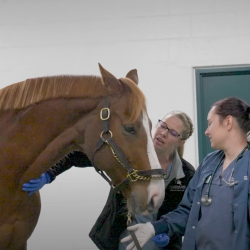This story features Bharadhwaj Ranganathan, BVSC and AH, MS, DACVS-SA; Tessa Adams, DVM; Caylen Erger, DVM; Isabel Greene, BS, LVT, VTS (SAIM)

History and Presentation
Maverick, a nine-month-old black Labrador retriever, was presented to the MSU Veterinary Medical Center’s Primary Care service for further workup for a suspected giant kidney worm (Dioctophyme renale) infection.
Maverick’s owners initially brought him to his primary veterinarian after noticing blood in his urine. The owners had not noticed any change in Maverick’s energy, appetite, or behavior but did report that Maverick actively roamed their family’s rural estate and routinely hunted and killed the frogs found in the property’s three ponds. This background information was significant as frogs can be infected with D. renale larvae and pass on the parasite infection to other mammals that eat frogs.
While the initial physical examination and preliminary bloodwork did not reveal any significant renal abnormalities, an evaluation of Maverick’s urine sediment revealed substantial numbers of D. renale eggs. The primary veterinarian recommended seeking additional diagnostic tests and treatment at a specialty referral hospital.
An ultrasound performed by the MSU Diagnostic Imaging Service revealed large worms present in the right kidney and provided the evidence needed to definitively diagnose Maverick with dioctophymiasis. The ultrasonographer also discovered the right kidney’s internal structures had been completely destroyed by the worms and the decision was made to surgically remove the damaged kidney along with the adult worms.

Surgical Procedure
After being transferred to the Soft Tissue Surgery Service, members of the Anesthesia Service placed Maverick under anesthesia and a laparotomy was performed by the surgical team to facilitate a right-sided unilateral nephroureterectomy. The kidney was examined upon removal and appeared irregularly shaped with a thick outer capsule and accompanying tissue inflammation. A dissection of the kidney exposed two adult worms, a female and a male, and confirmed the ultrasound report of no discernible functional kidney tissue.
Following the surgery, Maverick recovered uneventfully from anesthesia and was carefully monitored for post-operative complications in the Intensive Care Unit. Maverick quickly rebounded from the surgical procedure and was discharged to go home a few days later.
Comments
Dioctophyme renale, or the giant kidney worm, is the largest known nematode (or roundworm). Adult male worms average a length of 20–40 cm, while female worms can reach a meter in length. Minks and other freshwater fish-eating carnivores are the usual final hosts of giant kidney worms. Rarely does dioctophymiasis occur in other mammals, such as dogs, cats, or humans. Infection with D. renale happens when the final host ingests raw or uncooked infected frogs or freshwater fish.
Adult worms live within the kidney and release unembryonated eggs in urine that become embryonated in the environment and are consumed by the primary intermediate hosts (freshwater worms). Frogs and freshwater fish are known to be the giant kidney worm’s secondary intermediate hosts (paratenic or transport hosts) because they prey on infected blackworms or freshwater worms. The consumed eggs then develop into larvae.
Infections may go undiagnosed for years, as the unaffected kidney can compensate for the infected kidney, resulting in minimal overt clinical signs. Animals exhibiting clinical signs may demonstrate pain, blood in urine, or fever. Diagnosis is made by identifying eggs in urine and through ultrasound imaging of the kidneys. Commonly used anti-nematode/anti-parasitic drugs are ineffective, as they cannot reach the kidney to kill the adult worms. Usually, at the time of diagnosis, the kidney has been destroyed. Consequently, surgery is the primary treatment to remove the affected kidney with adult worms.




